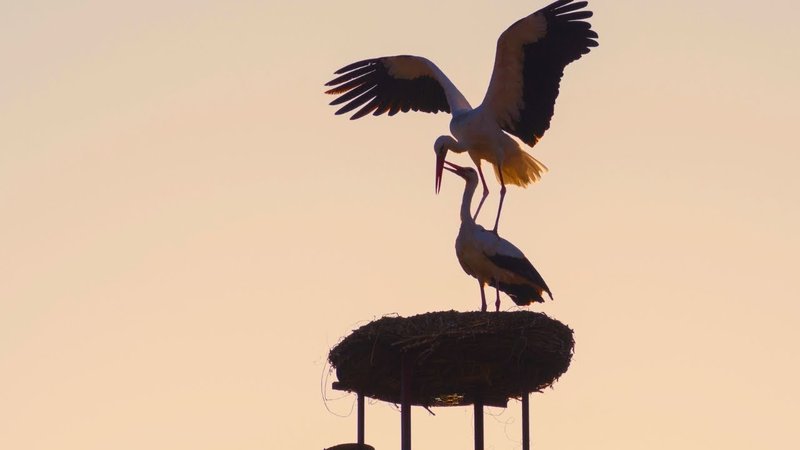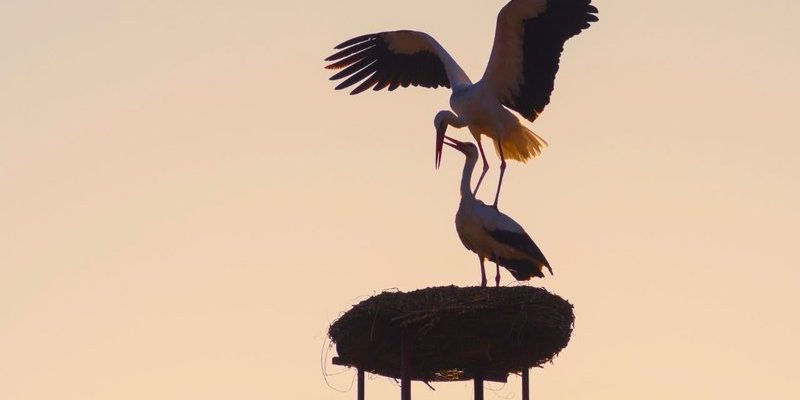
Storks are large, long-legged birds that belong to the family Ciconiidae. Their mating rituals aren’t just a matter of survival; they also play a crucial role in maintaining social bonds and cultural practices among stork species. Picture it like a grand performance, where both parties are dedicated to putting on a show that highlights their best traits. You might be surprised by how similar their rituals are to human courtship, filled with displays of strength, commitment, and those charming little quirks that make each connection special.
1. The Dance of Attraction
In the world of storks, the first step in courtship is often a spectacular dance. These birds have a fascinating way of communicating their intentions by performing various movements that catch a potential mate’s eye. Think of it like a dance club, where the music is the rhythm of nature, and the dance floor is a wide-open field. When a male stork spots a female, he often begins with a series of wing flapping and head bobbing, which is not only a display of strength but also a way to announce his presence.
During this ritual, you’ll see the male puffing out his chest and raising his wings to make himself look larger. It’s a bit like a peacock showing off its feathers! This display isn’t just for show; it helps convey strength and vitality, important traits for a potential mate. The female stork will watch closely, evaluating his performance. If she’s impressed, she might respond with her own movements, showcasing her interest.
The Importance of Location
The setting plays a critical role in these mating dances. Storks prefer open fields and wetlands, where they can easily be spotted by potential partners. These areas are not just good for visibility; they also provide abundant resources like food and nesting materials. Being in the right place at the right time can mean the difference between success and failure in attracting a mate.
2. Building the Nest Together
Once a pair of storks form a bond, the next step is often constructing a nest together. This isn’t just a practical affair; it’s a significant part of their courtship. Working together to build a sturdy nest symbolizes their commitment to each other and their future family.
Storks typically choose high, prominent locations for their nests, such as treetops or rooftops. They collect sticks, grass, and other materials, and you’ll often see them flying back and forth, working as a team. This collaborative effort highlights their mutual trust and cooperation—essential ingredients for a successful partnership.
You might be wondering, “What does a stork nest look like?” Well, it’s a large platform, often quite messy, but functional. It serves as a safe haven for their young once they hatch, nurturing the next generation of storks.
3. Vocalizations: The Language of Love
Storks communicate through a series of vocalizations, which play a significant role in their courtship rituals. These calls are a way to establish territory, signal distress, or simply connect with a mate. When a male stork wants to impress a female, he’ll often produce a variety of clattering sounds by snapping his bill shut. This rhythmic clattering is like a romantic serenade and is often accompanied by the aforementioned dance.
These vocalizations are more than just sounds; they convey a wealth of information about the stork’s health, fitness, and readiness to mate. Each call has its own meaning, helping partners stay in sync as they prepare for their life together.
Non-verbal Communication
Of course, communication isn’t just about sounds. Storks also use body language extensively during courtship. Head tilts, wing displays, and even the positioning of their bodies can say a lot without a single word being spoken. This reliance on non-verbal cues is reminiscent of human interactions—where sometimes a glance or a gesture can say more than words ever could.
4. Pair Bonding and Commitment
Once storks have successfully completed their courtship rituals, they typically form a long-lasting bond. Most stork species are monogamous, meaning they will mate with the same partner for several breeding seasons. This enduring commitment is akin to a marriage, with both partners working together to rear their young.
The bonding process often includes mutual preening, where one stork will groom the feathers of another. This act strengthens the connection between them, showcasing trust and affection. You might think of it as an intimate conversation, deepening their relationship as they prepare for the responsibilities ahead.
The Role of Family
Interestingly, family dynamics also come into play during the mating season. Once the young storks hatch, both parents are involved in caring for them. This teamwork is vital for the survival of their chicks, and it mirrors the way many human families operate, where each partner has roles to play. The commitment shown during mating extends to parenting, ensuring the next generation can take flight.
5. Challenges in the Courtship Process
Despite the beauty of their courtship rituals, storks face several challenges that can affect their mating success. Habitat loss, climate change, and human encroachment significantly impact their breeding grounds and available resources. Without safe nesting locations and adequate food supplies, these majestic birds may struggle to find mates and raise their young.
In addition, competition among males can be fierce. Sometimes, a lone male stork will have to outshine competition to win over a female. This rivalry can lead to conflicts during the courtship process, and failure to impress might mean he has to start all over again.
Conservation Efforts
Fortunately, conservation groups work hard to protect stork habitats. Restoring wetlands and maintaining natural spaces ensures these birds can continue their beautiful courtship rituals. By understanding what challenges they face, we can better appreciate the complexities of their mating behavior.
6. Storks Across Cultures
The stork’s courtship rituals have not only fascinated scientists but also inspired various cultural stories and myths. In many cultures, storks symbolize love, fidelity, and family. Their elaborate mating displays have been immortalized in literature and art, often representing the cycle of life and the joy of new beginnings.
You might have heard the popular saying that storks bring babies. This charming idea originates from observing these birds around the time of year when many babies are born, tying them to family and new life. Storks are often depicted as delivering infants to their families, creating a lovely connection with human experiences of love and courtship.
Global Stork Species
Different species of storks, like the White Stork and the Black Stork, have their own unique courtship practices. While the core rituals remain similar, the nuances vary based on regional behaviors and environmental factors. So, whether you find yourself watching storks in the lush wetlands of Europe or the savannas of Africa, the essence of their courtship remains captivating.
In conclusion, the courtship and mating rituals of storks are a remarkable blend of dance, communication, and commitment. From their impressive displays to their collaborative nesting efforts, these birds showcase a deep understanding of partnership and family. As we learn more about their behaviors, we not only appreciate the beauty of their rituals but also recognize the importance of protecting their habitats for future generations to enjoy. So, next time you spot a stork, take a moment to appreciate the love story unfolding before your eyes!

